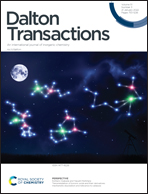Pyridylarsine-based Cu(i) complexes showing TADF mixed with fast phosphorescence: a speeding-up emission rate using arsine ligands†
Abstract
Can arsine ligands be preferred over similar phosphines to design Cu(I)-based TADF materials? The present study reveals that arsines can indeed be superior to reach shorter decay times of Cu(I) emitters. This has been exemplified on a series of bis(2-pyridyl)phenylarsine-based complexes [Cu2(Py2AsPh)2X2] (X = Cl, Br, and I), the emission decay times of which are significantly shorter (2–9 μs at 300 K) than those of their phosphine analogs [Cu2(Py2PPh)2X2] (5–33 μs). This effect is caused by two factors: (i) large ΔE(S1–T1) gaps of the arsine complexes (1100–1345 cm−1), thereby phosphorescence is admixed with TADF at 300 K, thus reducing the total emission decay time compared to the TADF-only process by 5–28%; (ii) higher SOC strength of arsenic (ζl = 1202 cm−1) against phosphorus (ζl = 230 cm−1) makes the kr(T1 → S0) rate of the Cu(I)–arsine complexes by 1.3 to 4.2 times faster than that of their phosphine analogs. It is also noteworthy that the TADF/phosphorescence ratio for [Cu2(Py2AsPh)2X2] at 300 K is halogen-regulated and varies in the order: Cl (1 : 1) < Br (3 : 1) ≈ I (3.5 : 1). These findings provide a new insight into the future design of dual-mode (TADF + phosphorescence) emissive materials with reduced lifetimes.



 Please wait while we load your content...
Please wait while we load your content...